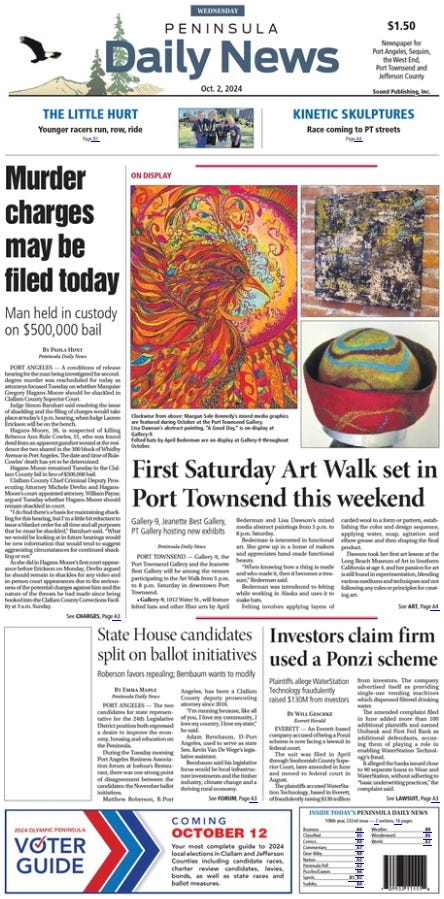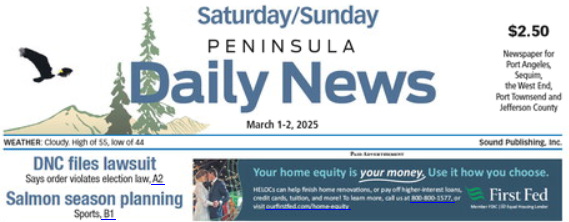Local news is supposed to serve the public, but what happens when financial interests take precedence? A tale of two lawsuits reveals how advertising dollars influence coverage. One hometown paper withheld key documents on potential misuse of taxpayer funds—then later ran a glowing ad for a supporter of the very project tied to that misuse. After floating the idea of taxpayer-funded media, one commissioner has been handed a journalism gig to report on himself.
Earlier this month, the front page of the Peninsula Daily News (PDN) reported on a lawsuit alleging workplace harassment at Strait View Credit Union. It was a well-written story, by a local reporter, and it deserved coverage.
However, PDN underreported a far more financially significant lawsuit. Last September, a federal lawsuit was filed against First Federal Bank for allegedly assisting WaterStation Technology (WST) in running a Ponzi scheme. The plaintiffs accused WST of fraudulently raising approximately $130 million from investors, promising returns between 12-20%, and directing them to obtain loans from regional banks—including First Federal Bank. The lawsuit claimed First Fed issued nearly 90 loans without proper underwriting, effectively enabling the fraud.
The suit against First Fed was dismissed without prejudice from federal court, with a new lawsuit later filed against the bank in King County.
Major news outlets, including Yahoo Finance, Law360, American Banker, and Banking Dive, reported on the lawsuit. PDN ran only one article about it back in October—authored by the Everett Herald—not by its own reporters.
The first mention of First Fed appeared in the fourth paragraph, and the bank was only referenced once more in the article. Given First Federal’s deep financial and employment ties to the Olympic Peninsula, the lack of coverage raises concerns.
First Federal’s advertising dollars may provide an explanation. Their banner ads are prominently displayed atop PDN’s widely circulated Weekend Edition, where a full-color weekend banner ad costs $650 and a quarter-page color ad runs $970.
A pattern of suppression
This isn’t an isolated case. In November 2023, I met with the editor of the Sequim Gazette and presented emails in which Commissioner Mark Ozias told a landowner that he was working on taxpayer-funded, electric, automatic gates for their property. In the same exchange, Ozias asked to continue the conversation “NOT on county time or my county device.” Despite expressing initial interest, the Gazette never ran the story. That editor has since taken a job as a communications specialist for the Jamestown Tribe.
Later, I also submitted evidence, backed by publicly available documents, showing Clallam County government’s involvement in covering up a sovereign nation’s deliberate actions that exposed downriver communities to a mass casualty event, costing taxpayers an estimated $13 million. Local media ignored the story. Instead, the Sequim Gazette recently ran a two-page color insert written by Jamestown Tribe CEO Ron Allen, praising the Tribe’s economic contributions. The cost of this ad is unknown, but a half-page weekend color ad costs $1,520. Was this a paid promotion or an uncritical platform granted to a powerful entity?
Journalism or public relations?
The pattern is clear: stories that challenge influential figures or major advertisers are suppressed, while favorable coverage—including paid inserts masquerading as news—is given prominence.
Now, Mark Ozias has announced that the Sequim Gazette has offered him a monthly column to discuss county business. This comes after he previously suggested taxpayer-funded support for local media. Given the Gazette and PDN’s track record of selective reporting, this raises serious concerns. If ad revenue already dictates coverage, what happens when media becomes reliant on government funding and content?
Local media is at a crossroads. It can rebuild trust by prioritizing journalistic integrity over financial interests, or it can continue down a path where revenue dictates content. But if publications like PDN and the Gazette choose the latter, they shouldn’t expect taxpayers to fund their survival. The future of truly independent journalism belongs to those willing to report the truth—no matter who it upsets.








Wow free press? I think we have a TOWN CRIER IN CC WATCHDOG. Thanks Jeff and posters. I would be blissfully blind without you.
Wow, I’m so disappointed that my conspiracy thinking continues to be proven right. How hard is it to have actual reporting that isn’t swayed by ad dollars? Truthful news is interesting as are the local and diverse people. Why can’t that be the goal for journalism?
If printed news continues with paid-for narratives, they will become just more junk history.
As readers, we don’t have to take that. My opinion, both publications have had shallow information ponds for years.